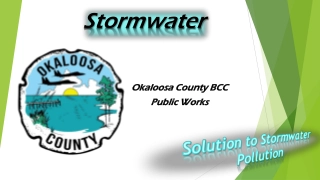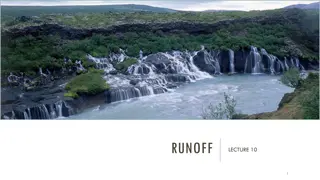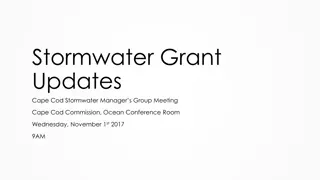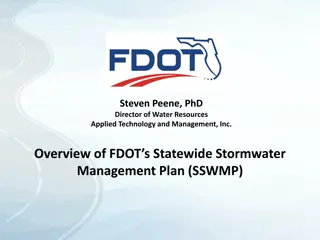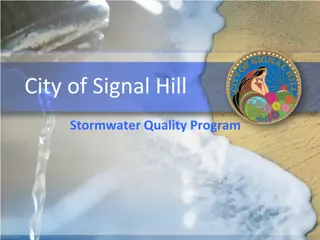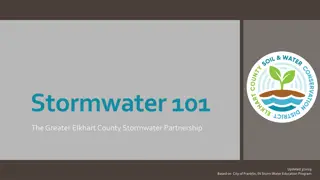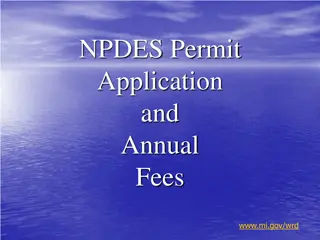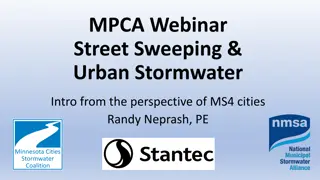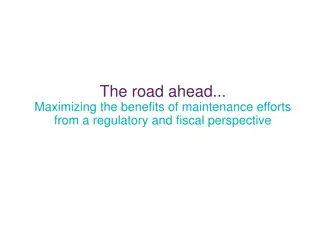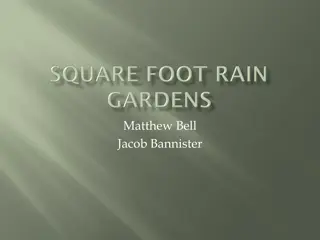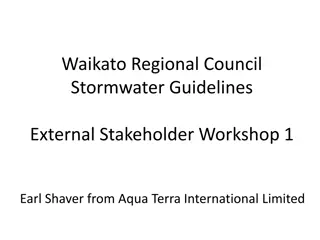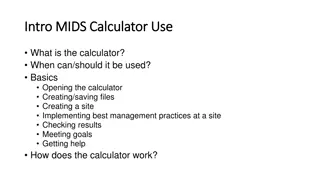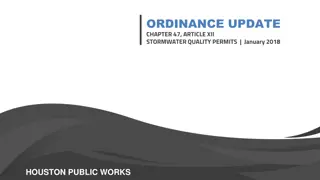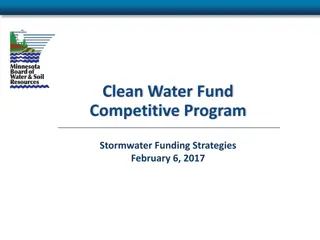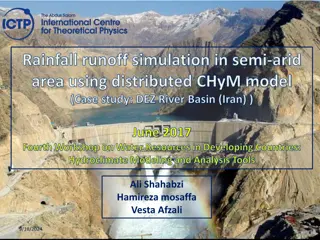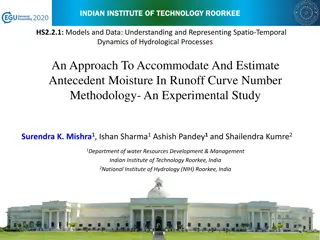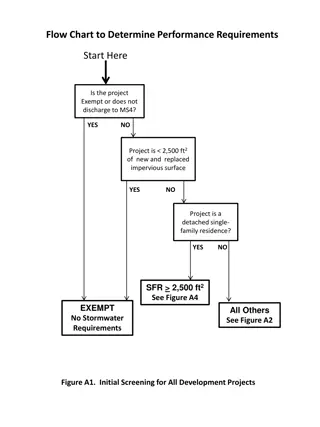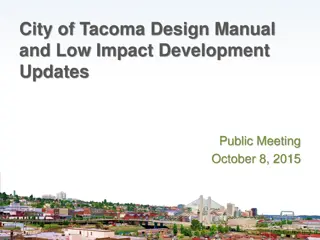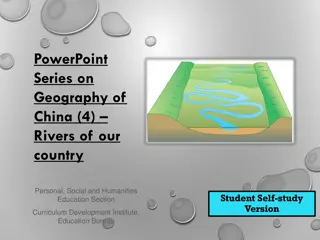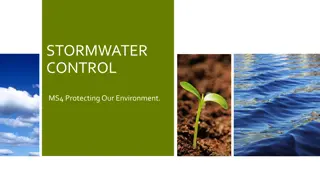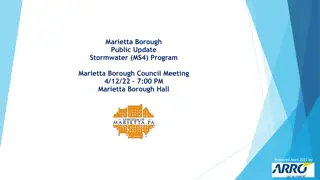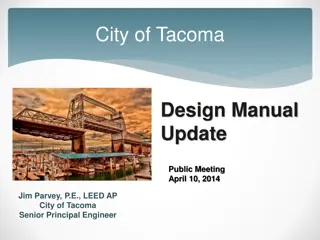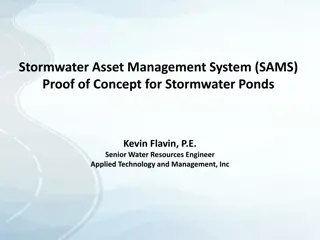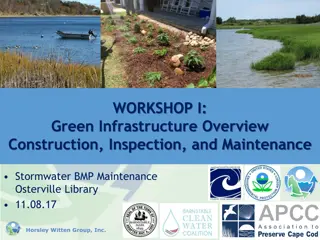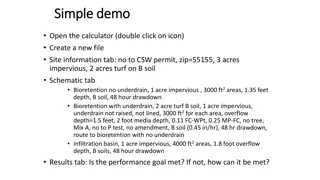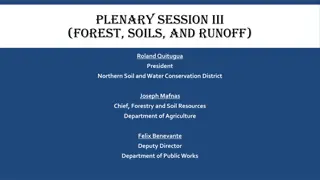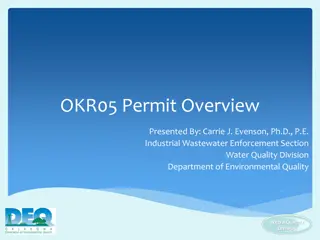Stormwater
Stormwater is excess water from rain/snow that can cause pollution if not managed properly. It can pick up pollutants and flow into water bodies, impacting the environment. Keeping stormwater clean involves individual actions like proper waste disposal, yard care, and car maintenance. Infrastructure
0 views • 10 slides
Rainfall-Runoff Modelling Using Artificial Neural Network: A Case Study of Purna Sub-catchment, India
Rainfall-runoff modeling is crucial in understanding the relationship between rainfall and runoff. This study focuses on developing a rainfall-runoff model for the Upper Tapi basin in India using Artificial Neural Networks (ANNs). ANNs mimic the human brain's capabilities and have been widely used i
0 views • 26 slides
Runoff
Runoff is the surface flow of precipitation in drainage channels that can be utilized for engineering purposes. Catchment characteristics, including stream order, drainage density, length of stream, form factor, and circularity ratio, play a crucial role in determining how well a watershed is draine
3 views • 30 slides
Understanding Runoff in Hydrology
Runoff in hydrology refers to surface water flow from precipitation and other sources in drainage basins. It plays a crucial role in stream flow and peak flood formation, influenced by factors like overland flow, interflow, and groundwater flow. This article explores the sources of runoff, including
3 views • 27 slides
Understanding Human Impact on Water Systems in Agriculture
Human activities, such as animal farming, can significantly impact the Earth's surface and water systems by introducing excess nutrients and waste runoff. This leads to eutrophication, soil erosion, and water contamination. Farmers are working on conservation practices to mitigate these issues, such
2 views • 10 slides
Understanding Runoff in Surface Water Systems
Runoff, the flow of precipitation and other contributions in surface streams, plays a crucial role in watershed systems. It encompasses various sources such as surface runoff, interflow, and base flow. Surface runoff, which travels over the ground surface to channels, is influenced by factors like s
1 views • 27 slides
Cape Cod Stormwater Grant Updates & Municipal Assistance Program
This document provides comprehensive details on the Cape Cod Stormwater Grant Updates, DLTA MS4 Permit Compliance Assistance, and Municipal Assistance Program. It covers grant tasks, program components, GIS mapping assistance, Geospatial Tech Assistance, and various initiatives aimed at improving st
0 views • 19 slides
Understanding Hyetograph, Runoff, and Hydrograph in Hydrology
A hyetograph represents rainfall intensity over time, crucial for predicting extreme floods. Runoff is the unevaporated portion of rainfall that flows into rivers or oceans, while hydrograph displays discharge variations over time in streams. Surface runoff, interflow, and base flow are key classifi
0 views • 15 slides
Understanding FDOT's Statewide Stormwater Management Plan (SSWMP)
The Statewide Stormwater Management Plan (SSWMP) is a crucial document developed by FDOT to reduce pollutant discharge in Phase 1 MS4s. It is required under Phase I MS4 permits by FDEP's NPDES program and falls under the Clean Water Act. The SSWMP applies primarily in 15 Phase I Permit Counties but
1 views • 13 slides
City of Signal Hill Stormwater Quality Program Overview
The City of Signal Hill, known for its unique geographic characteristics and historical oil production legacy, is proactive in implementing stormwater quality programs. The city addresses MS4 and TMDL requirements, demonstrating regional leadership in environmental initiatives. With a population of
1 views • 42 slides
Understanding the Greater Elkhart County Stormwater Partnership
The Greater Elkhart County Stormwater Partnership plays a vital role in managing stormwater in the region. Through initiatives such as the Municipal Separate Storm Sewer System (MS4) and Storm Water Quality Management Plans (SWQMP), they address key control measures to prevent pollution and ensure w
0 views • 18 slides
Understanding NPDES Permit Application and Fees in Michigan
NPDES permits in Michigan regulate the discharge of municipal, industrial, and commercial wastewater, as well as stormwater, into state surface waters under Act 451. The permit fees vary based on the type of discharge, with separate fees for stormwater and non-stormwater discharges. Industrial storm
1 views • 13 slides
Enhanced Street Sweeping for Effective Stormwater Management
Street sweeping plays a significant role in removing phosphorus and pollutants from urban environments. By implementing enhanced street sweeping programs based on tree canopy cover and phenology, cities can achieve cost-effective pollution reduction and meet TMDL WLAs. This approach can be integrate
0 views • 5 slides
Maximizing Maintenance Benefits for Environmental Compliance
Explore the significance of maintenance efforts in maximizing benefits from both regulatory and fiscal perspectives. Learn how routine maintenance activities such as pond cleaning, street sweeping, and litter control can lead to cost savings and regulatory compliance. Discover how keeping track of c
0 views • 18 slides
Managing Urban Stormwater Runoff: North Hennepin Community College MS4 Plan
North Hennepin Community College is designated as an MS4 due to its location in an urban area, aiming to treat urban stormwater runoff and improve water quality. The MS4 Plan includes implementing six minimum control measures, such as public education, illicit discharge detection, and construction s
0 views • 10 slides
Implementing Rain Gardens for Sustainable Stormwater Management
Rain gardens offer an affordable and effective solution for homeowners to reduce stormwater runoff on their property. They provide numerous benefits such as filtering pollution, conserving water, and enhancing wildlife habitats. While installation may require some initial costs, maintenance is minim
0 views • 21 slides
Waikato Regional Council Stormwater Guidelines Workshop Overview
The Waikato Regional Council organized an external stakeholder workshop to discuss their new stormwater guidelines, aiming to provide consistent hydrologic design practices in the region. The workshop highlighted the importance of a council-specific guideline, changes from TP 108, allowance for alte
0 views • 20 slides
Managing Stormwater in Infrastructure & Transport Planning: A Comprehensive Overview
Stormwater management is crucial for urban areas like Delhi due to heavy rainfall patterns and the risk of flooding. Factors influencing rainfall, runoff estimation methods, and water stagnation points are discussed. The importance of natural drainage systems in mitigating flooding is emphasized.
0 views • 5 slides
Understanding the MIDS Calculator for Stormwater Management
The MIDS Calculator is an Excel-based tool that helps quantify stormwater runoff volume reduction and pollutant removal for Best Management Practices (BMPs). It can assist in selecting and sizing BMPs to meet regulatory or water quality objectives. Despite some limitations, it is widely used and off
0 views • 14 slides
Stormwater Quality Permit Regulations in Houston Public Works - January 2018 Update
Houston's Stormwater Quality Permit regulations, based on the Clean Water Act, have evolved over the years, with updates in 2001, 2009, and more. The city's Chapter 47, Article XII outlines requirements for development projects, impervious surface increases, and non-stormwater sources. Stormwater Qu
0 views • 13 slides
Clean Water Fund Competitive Program Overview
The Clean Water Fund Competitive Program focuses on stormwater funding strategies and implementation of on-the-ground restoration activities to improve water quality. It prioritizes local resources, targets effectiveness, and measures impact. The program includes non-point priority funding plans, pr
0 views • 10 slides
Rainfall-Runoff Simulation in Semi-Arid Area Using Distributed CHyM Model: DEZ River Basin Study
This case study delves into the simulation of rainfall-runoff using the CHyM model in the semi-arid area of the DEZ River Basin in Iran. The study focuses on water resources management, flood control, and forecasting of flood discharge parameters, emphasizing the importance of accurate modeling for
0 views • 22 slides
Understanding Spatio-Temporal Dynamics of Hydrological Processes at IIT Roorkee
This study conducted at the Indian Institute of Technology Roorkee focuses on modeling and understanding hydrological processes, particularly in estimating antecedent moisture in the Runoff Curve Number methodology. The research delves into the historical background of the Soil Conservation Service
0 views • 13 slides
Stormwater Performance Requirements Flow Chart
A detailed flow chart outlining the performance requirements for stormwater management based on the size and type of development projects. The chart guides users through determining the necessary performance criteria for stormwater management based on project size, impervious surface area, and speci
0 views • 4 slides
Understanding Infiltration and Unsaturated Flow in Hydrology
This content delves into the key concepts of infiltration and unsaturated flow in hydrology, focusing on calculating infiltration, cumulative infiltration, and time to ponding using the Green-Ampt method. It covers important topics such as runoff rate, infiltration capacity, cumulative infiltration,
0 views • 8 slides
Essential Norms and Standards in Infrastructure and Transport Planning
Various issues are highlighted in the existing scenario of infrastructure and transport planning, such as determining run-off coefficients for different land uses, institutional frameworks for stormwater drainage in Delhi, and planning provisions in stormwater management. The content emphasizes the
0 views • 8 slides
City of Tacoma Design Manual and Low Impact Development Updates
The City of Tacoma held a public meeting in October 2015 to discuss updates to the Design Manual and Low Impact Development. The updates aimed to address current city policies, comply with state regulations, and promote Low Impact Development as the preferred approach to site development. Various re
0 views • 60 slides
Calibration of Multi-Variable Rainfall-Runoff Model Using Snow Data in Alpine Catchments
Explore the calibration of a conceptual rainfall-runoff model in Alpine catchments, focusing on the importance of incorporating snow data. The study assesses the benefits of using multi-objective approaches and additional datasets for model performance. Various aspects such as snow cover, groundwate
0 views • 16 slides
Distribution Pattern of River Zones in China
China has a vast network of rivers with different characteristics and distribution patterns. The country is divided into five zones based on factors like precipitation and runoff levels, ranging from abundant to deficit zones. These zones play a crucial role in understanding the water resources and
0 views • 14 slides
Understanding Stormwater Management and Best Management Practices
Stormwater management is crucial for protecting our environment from pollutants in runoff water. Best Management Practices (BMPs) are a combination of structural, vegetative, and managerial techniques used to prevent water pollution and improve water quality. Learn about stormwater pollution, minimu
0 views • 15 slides
Marietta Borough Public Update on Stormwater Program
Marietta Borough Council will discuss the Stormwater (MS4) Program at the upcoming meeting, covering topics such as the EPA's NPDES permit regulations, public education, illicit discharge detection, and pollution reduction plans. The program aims to manage stormwater discharges and comply with Penns
0 views • 17 slides
Innovative Stormwater Management Solutions for Urban Environments
Explore green infrastructure and low-impact development technologies for stormwater management in urban settings. Analyze real-world scenarios and design site plans integrating concepts like green roofs, bioswales, rain gardens, and permeable pavement. Consider traffic concerns, aesthetics, safety,
0 views • 12 slides
City of Tacoma Design Manual Update Meeting Overview
Updates to the City of Tacoma Design Manual were discussed in a public meeting in April 2014. The manual, last updated in 2004, needed revisions due to changes in surface water regulations. The focus was on making Low Impact Development (LID) the preferred approach for site development, aiming to mi
0 views • 11 slides
Stormwater Asset Management System (SAMS) Proof of Concept Overview
This project focuses on developing a Statewide Stormwater Asset Database and a GIS-based Stormwater Asset Management System (SAMS) for efficient inspection and reporting. It involves creating methodologies for database development, utilizing existing district data, implementing inspection protocols,
0 views • 27 slides
Green Infrastructure: Sustainable Stormwater Management Workshop
Explore the importance and benefits of green infrastructure for managing stormwater runoff, reducing environmental impacts, and promoting sustainable practices. Learn about bioretention systems, comparison with traditional methods, and the positive effects on water, energy, and air quality. Discover
0 views • 33 slides
Stormwater Management Calculator Overview
Explore the functionalities of a stormwater management calculator that helps in analyzing stormwater runoff, pollutants, and BMP efficiencies. Learn about different BMP types, performance goals, and annual pollutant reduction targets to achieve effective stormwater management. Understand how the cal
0 views • 14 slides
Water Harvesting Techniques in Rainfed Agriculture & Watershed Management
Water harvesting plays a crucial role in rainfed agriculture by collecting and storing runoff water for irrigation in arid and semi-arid regions. Mr. Anil Swami, an assistant professor, discusses the importance of water harvesting techniques, including runoff farming and rainwater harvesting. He emp
0 views • 13 slides
Plenary Session III on Forest, Soils, and Runoff Featuring Key Speakers
The Plenary Session III on Forest, Soils, and Runoff showcased insights from prominent figures such as Roland Quitugua, President of the Northern Soil and Water Conservation District, Joseph Mafnas, Chief of Forestry and Soil Resources at the Department of Agriculture, and Felix Benevante, Deputy Di
0 views • 4 slides
Overview of OKR05 Permit for Stormwater Regulation in Oklahoma
Presented by Dr. Carrie J. Evenson, this overview covers the regulatory history of stormwater permits in Oklahoma, from the Clean Water Act to the delegation of NPDES programs to ODEQ. It further explains the requirements for different phases of stormwater regulations and DEQ's authority over stormw
0 views • 53 slides
Exploring Watersheds and Runoff with Physical and Computational Models
Engage in hands-on activities using physical models like a big tarp to simulate rainfall on landscapes and explore the movement of water. Dive into discussions about the pros and cons of using physical models for studying water flow. Discover the introduction to computational models and discretizati
0 views • 38 slides
